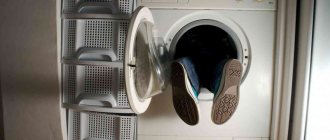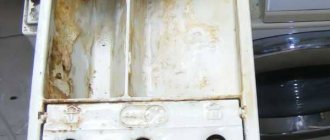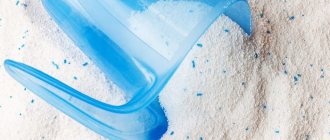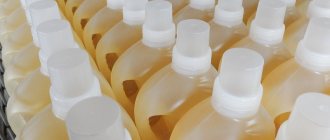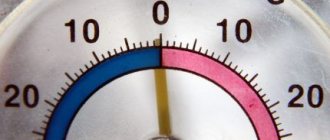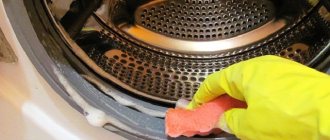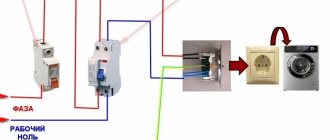From numerous commercials, you know how to clean the heating element of a washing machine, which eventually fails due to hard water. The advertised products are quite expensive, and not everyone can afford to use them constantly.
But, as with many products, you can find equally effective and much cheaper analogues, so next we will look at how to rinse an automatic washing machine with citric acid so as not to harm it and use it for many more years.
Is it possible to clean a washing machine with citric acid?
The operation of the washing machine depends on the quality of the water: if it is hard, scale forms on the heating elements and drum.
Scale prevents water from heating and can damage the heating element. Therefore, when washing, you need to add special water softening agents to the powder. An inexpensive and effective chemical analogue is citric acid. It helps remove hard deposits, mold, limescale and unpleasant odors. Advantages of cleaning a washing machine with citric acid:
- low cost;
- environmental friendliness;
- does not harm metal parts;
- safe for human health.
The acid dissolves quickly in water and does not form sediment.
The substance cleans metal well, but can damage rubber and plastic parts. Therefore, take precautions and adhere to the recommended dosage of the product.
Possible harm to the machine
Citric acid can be harmful only if the dosage and temperature conditions are not observed. If you pour too much of it and set the program to 90 degrees, cleaning will negatively affect the condition of the rubber parts: the seal on the door, seals on the bearings, pipes near the pump, etc. The rubber will lose elasticity, begin to crack and crumble, which threatens water leakage and serious damage to the washing machine.
Also, damage can be caused to things if you do not remove them from the machine when cleaning or combine the procedure with regular washing. Citric acid steals the color from bright fabrics, they become dull and cannot be restored.
How to choose citric acid
The composition of the powder is the same for each manufacturer. Therefore, when choosing citric acid, pay attention not to the brand, but to the integrity of the packaging: the bag must be dry - if the powder gets wet, it will lose its effectiveness.
For one descaling cycle, you will need about 200 g of citric acid. How many bags to buy depends on the packaging: manufacturers usually pack the powder in 10, 20 and 50 g.
Do not replace the citric acid in the powder with fresh lemon juice. Despite their similar names, they have different compositions and concentrations: lemon juice will not help remove limescale and scale.
Which washing mode to choose
The solvent properties of citric acid are enhanced by high temperature. Cleaning should be done in a washing mode up to +95℃. If there is little scale, then a temperature of +60℃ is sufficient. Such modes in automatic machines require a long cycle - up to three hours. If you need to set the time in your model yourself, set it to 2–3 hours.
To prevent the acid from damaging individual parts of the machine, you need to thoroughly clean all surfaces after treatment. Therefore, you need to set the double rinse mode and wipe the drum and rubber cuffs well so that no small grains of citric acid remain on them.
How to treat a drum
First - preparation. Before the procedure, make sure that there is no laundry in the drum: acid can damage the fabric. Check to see if there are any small items left inside: buttons, paper clips, paper napkins. Wipe the rubber cuff with a soft, dry cloth or sponge to remove any water droplets or visible dirt.
Don't be afraid to run your washing machine without any laundry. Household appliance repair specialists recommend regularly performing “idle” starts to clean the machine and prevent the formation of solid deposits.
Next, start cleaning the drum:
- Calculate the dosage depending on the size of the machine's tank.
- Pour citric acid into the powder compartment, and if there is mold or an unpleasant odor in the drum, then put the acid directly into the tank.
- Set the mode, turn off the spin and select double rinse.
- Make sure that there are no grains of citric acid left in the drum, and that there is no white residue on the rubber seal.
- At the end of the cycle, open the hatch and thoroughly wipe the powder compartment, drum and door rubber with a rag or sponge soaked in clean water.
- Leave the hatch open and do not use the washing machine for 24 hours to allow all parts to dry.
Be sure to check for damage to the machine parts. There should be no water or citric acid residue anywhere. Inspect the powder and conditioner container, tank, door rubber, all holes and filter screens in front of the drain pump. You can get the mesh by opening the cover on the front panel of the machine.
How often can you clean your washing machine with citric acid?
Citric acid is an aggressive agent, especially when washing at high temperatures. That is why it copes well with dirt, scale and limescale. In order not to harm the washing machine, you should use this cleaning method no more than once every six months.
If you wash in very hard water, then you need to clean the machine more often - once every 1-2 months.
You also need to clean the tank regularly if you wash frequently: it is recommended to clean it after 30 cycles or every three months.
Sometimes you can tell when it’s time to clean your washing machine based on the following signs:
- deposits have formed on the powder container or drum;
- the time for heating the water and the washing cycle has increased;
- an unpleasant odor appeared in the drum;
- When washing at temperatures above 60℃, the machine makes unusual noise;
- stains or a gray tint appear on the washed laundry;
- The consumption of washing powder has increased.
If you notice at least one sign, you can safely start cleaning your household appliances.
Alternative methods at hand
Citric acid is not the only home remedy that will help clean your washing machine and get rid of unpleasant odors.
Table vinegar
Regular table vinegar can deal with scale: it quickly destroys hard deposits and removes limescale. Here's what to do:
- Pour 150 ml of 4% vinegar into the detergent compartment or directly into the drum and start the wash.
- During washing, you can pause the machine to allow the acetic acid to soften the dirt.
- Start rinsing.
After the procedure, be sure to wipe the tank and the rubber of the hatch with a damp cloth and open the door to let the car dry.
Baking soda
To remove limescale from your car, you can use baking soda. Procedure:
- Dissolve soda in water in a 1:1 ratio.
- Soak a napkin in the solution and thoroughly wipe all visible elements: drum, powder compartments, door rubber.
- Time it for 25 minutes.
- Set the machine to quick wash mode and start working.
- Finally, turn on the rinse mode.
To enhance the effect, use baking soda and vinegar:
- Prepare a solution by mixing vinegar and soda in equal proportions (0.5 cups each).
- Pour the resulting mixture into the washing powder compartment.
- Additionally, pour a glass of vinegar into the drum.
- Set the temperature to maximum and start the wash.
- Finally, open the door to let the machine dry.
White
Another inexpensive way is to use white. With its help you can get rid of bacteria, scale, dirt and plaque. What to do:
- Add white to the washing powder compartment (from 0.5 to 1 bottle depending on the degree of soiling of the machine).
- Set the maximum washing temperature (at least +90℃) and start the machine.
- At the end of the cycle, turn on the rinse mode.
The disadvantage of this method is the risk of damage to internal parts and a specific persistent odor. To get rid of it, add a glass of table vinegar to the powder compartment and run the quick wash cycle.
Advantages
Cleaning the heating element of a washing machine using citric acid is the simplest, most accessible, and most importantly the cheapest way to get rid of scale that currently exists. Calling a professional and purchasing special water softeners costs several orders of magnitude more.
Another advantage of such cleaning is its absolute safety - citric acid in small quantities does not cause any harm to human health, its residues, along with water, end up in the sewer after the wash is completed. In contrast to this product, microparticles of special compositions often remain on clothing and can cause an allergic reaction.
As for the effectiveness of the procedure, experts say the following: citric acid copes well with solid deposits (scale). With its help, you can clean the heating element of the device no worse than using store-bought chemical compounds. By the way, citric acid belongs to the class of carbonic compounds that react with metals and salts, and therefore are used in the process of creating many professional cleaning products.
Read also: Do-it-yourself pipe chain wrench
Alternative special means
Let's look at popular products.
Dr. Beckmann
- a German cleaner that can be used for all internal elements of washing machines: drum, heating element, pipes. The cleaner eliminates unpleasant odors, scale, and limescale.
To clean the tank, pour 250 g of powder into the machine drum and turn on the wash at +60℃. There is no need to add other detergents or use a prewash program. The laundry should be removed from the tank. Repeat the procedure every 2–3 months
Topper
— express cleaner from Italy for automatic machines. Removes scale, plaque, dirt, and odor. Safe for metal plastic and rubber machine parts. Before using it, you need to empty the tank of laundry, pour the product into the drum, set the temperature to 60℃ without pre-washing. The manufacturer recommends using the product no more than three times a year.
MAGIC POWER
produced in Germany and shows excellent results in removing scale. The product removes limescale from the surface of the drum and tank. Sold in liquid form of 250 ml. The product must be poured into the washing powder compartment and the wash cycle started.
Causes and consequences of scale formation
Limescale inside household appliances is a deposit of chemicals that occurs under the influence of heat.
To form such a layer, the presence of calcium and magnesium carbonate or bicarbonate crystals in the water is required.
The process of scale formation in a washing machine is as follows:
- The water entering the device is heated using heating elements.
- The carbonates and bicarbonates of calcium or magnesium present in it decompose into carbon dioxide and insoluble sediment.
- The latter sticks to the surface of the heat exchanger, gradually increasing the thickness of the layer.
If powders or liquid detergents without phosphates are regularly used for washing, this accelerates the process of scale formation.
The consequences of salt deposits gradually disable the washing machine, negatively affecting its performance:
- The thermal conductivity of the metal deteriorates. This means that the heating time of the water increases and the energy consumption increases significantly. Due to long-term continuous operation, the heating element burns out;
- deposits on the heating element and tank walls cause additional friction of the elements and wear them out;
- pieces of plaque flake off the surface and get stuck in the outlet valve. Gradually it fails;
- deposits block air access to metal and rubber parts, which leads to the formation of rust and mold.
Did your washing machine break down due to scale?
Not really
conclusions
- If the water takes a long time to heat up during washing, the drum smells unpleasant, and stains and stains appear on the clothes after washing, this is a reason to clean the washing machine.
- You can use folk remedies: citric acid, vinegar or whiteness. The detergents are poured into the tank and the washing mode is set to high temperature. After the procedure, you need to thoroughly rinse the drum and other parts of the machine so as not to damage the equipment. If you are afraid of doing something wrong, it is better to buy special household chemicals.
- To prevent the appearance of solid deposits, experts recommend washing clothes at a temperature of no more than +65–70℃ and using high-quality washing powders and gels. In regions with hard water, special store-bought products will protect you from scale.
Prevention
To clean the internal parts as little as possible, you should use preventive products that soften the water and prevent the formation of sediment.
You can soften water using a filter that is installed on water pipes or directly on the washing machine hose. You can also purchase a water softener in tablet form, such as Calgon.
Alternate powder with liquid laundry detergents.
For washing, choose traditional powders correctly - gels are much worse for rinsing from the internal parts of the machine (it is wise to alternate powder with liquid laundry detergents).
An alternative means for cleaning the internal parts of a washing machine from scale and mineral deposits is vinegar.
You can also use improvised means, for example, ordinary 9% vinegar . It can be used simultaneously with washing clothes by adding it to the conditioner compartment. In addition to the fact that vinegar will prevent plaque, it will also soften clothes and eliminate the smell of powder.
It is also useful to start the machine in idle mode from time to time, pouring 1 liter of white . The product removes mold and soap residue from the internal parts of equipment.
These simple methods for cleaning heating elements from scale and preventing its formation significantly extend the life of the electric heater and eliminate the need to replace it with a new one.


